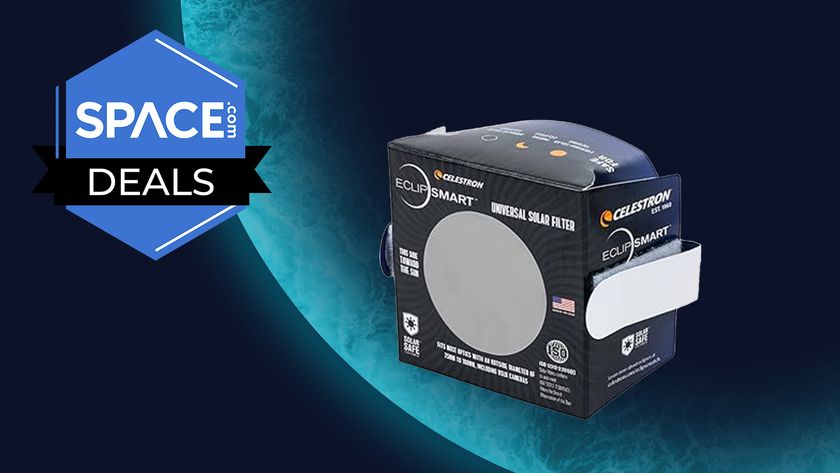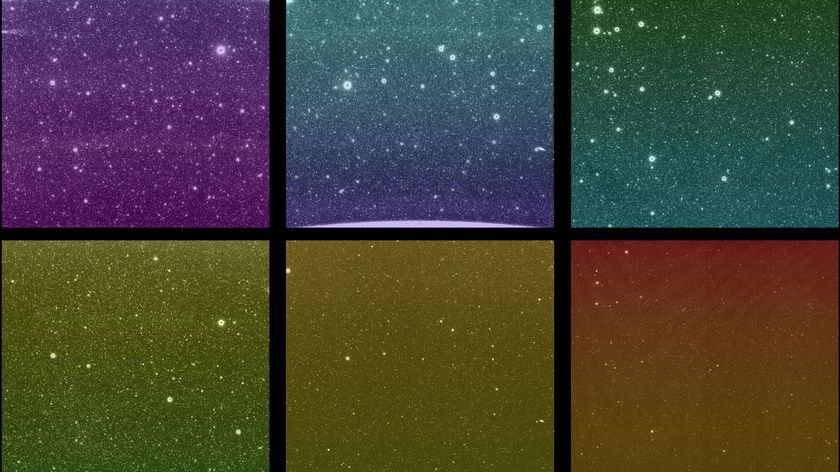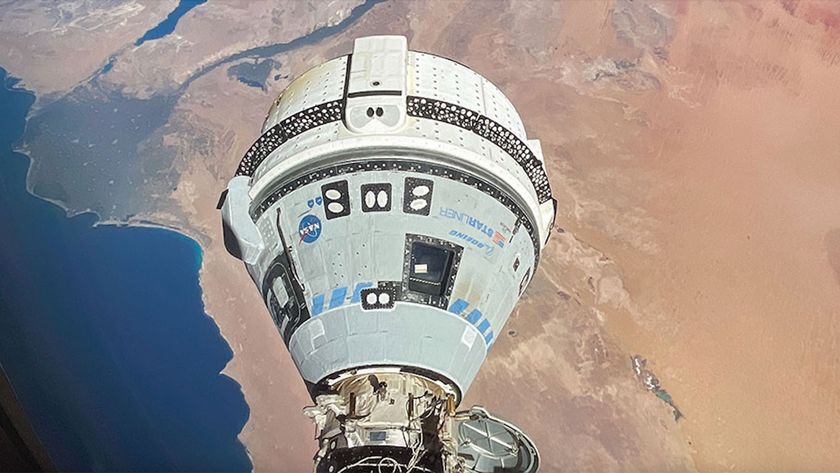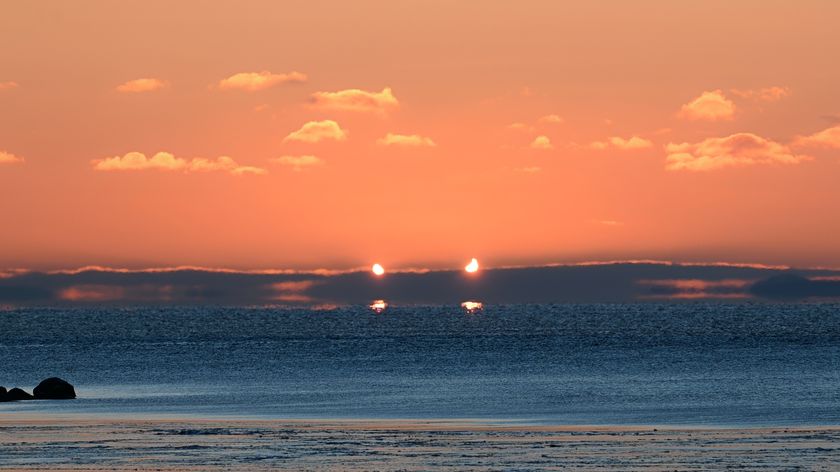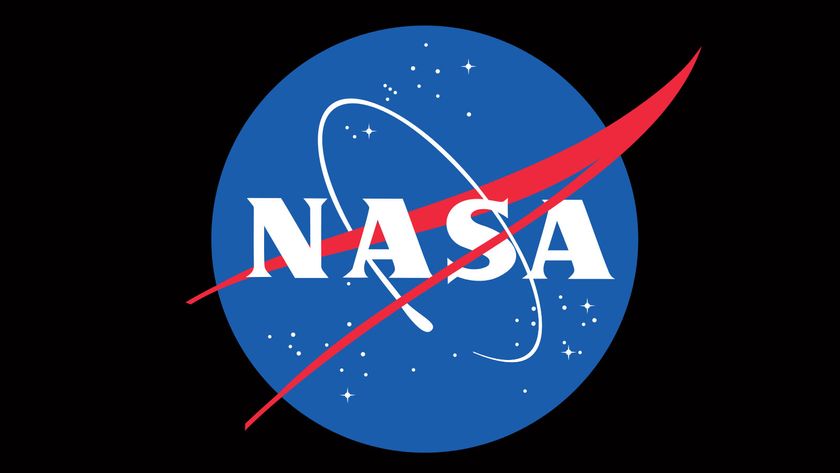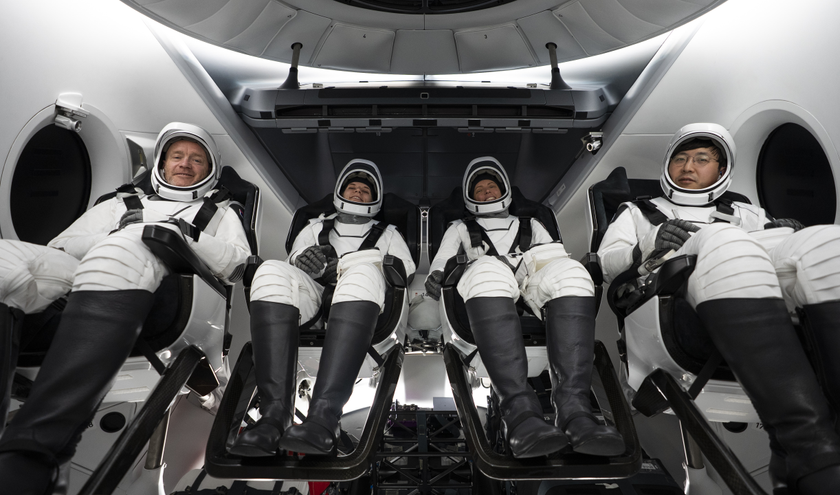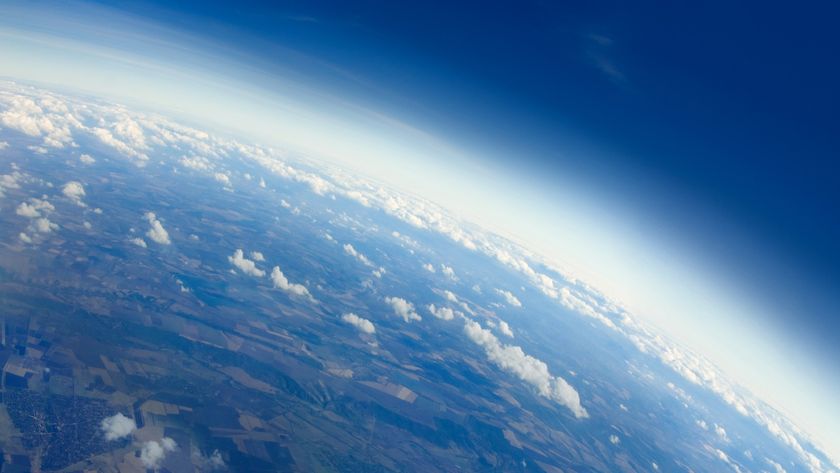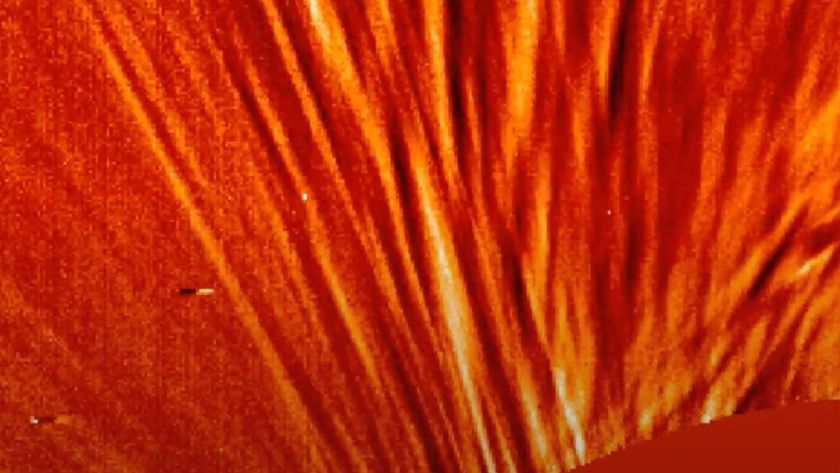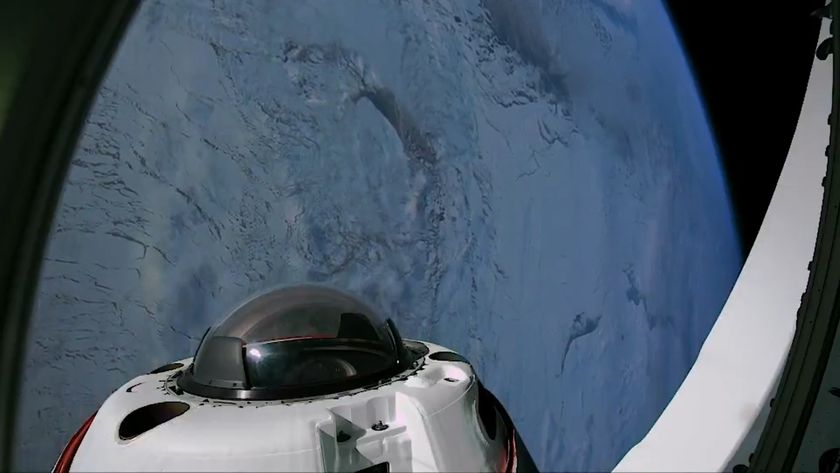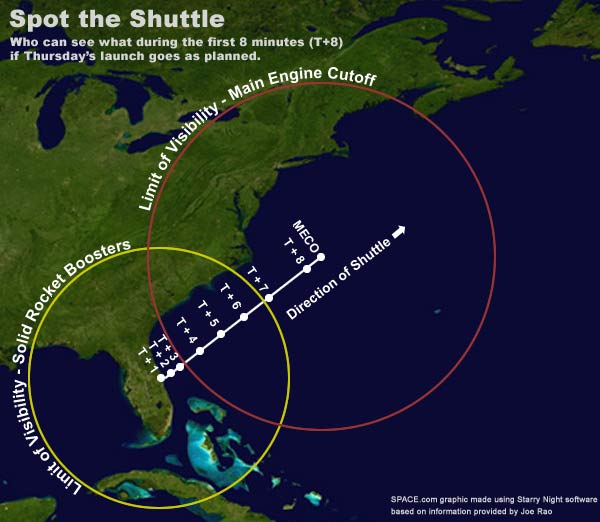
People in the eastern United States will get a great opportunity, weather permitting, to see the Space Shuttle Discovery launched into orbit Thursday evening.
The shuttle flight (STS-116) will be the 20th to rendezvous and dock with the International Space Station (ISS) and the glow of its engines will be visible along much of the Eastern Seaboard of the United States [Map].
| 10 ... 9 ... 8 ... Should the Dec. 7 launch be postponed, it could be rescheduled to one of the following dates and times: Dec. 8, 9:13 p.m. EST Dec. 10, 8:25 p.m. ESTDec. 11, 7:59 p.m. ESTDec. 13, 7:11 p.m. ESTDec. 15, 6:23 p.m. ESTDec. 17, 5:35 p.m. EST If Thursday's launch is and moved to any of these times, this viewing guide remains, though you'll need to adjust for the differing times. Countdown Quiz >>> | 10 ... 9 ... 8 ... | Should the Dec. 7 launch be postponed, it could be rescheduled to one of the following dates and times: Dec. 8, 9:13 p.m. EST Dec. 10, 8:25 p.m. ESTDec. 11, 7:59 p.m. ESTDec. 13, 7:11 p.m. ESTDec. 15, 6:23 p.m. ESTDec. 17, 5:35 p.m. EST If Thursday's launch is and moved to any of these times, this viewing guide remains, though you'll need to adjust for the differing times. Countdown Quiz >>> |
| 10 ... 9 ... 8 ... | ||
Should the Dec. 7 launch be postponed, it could be rescheduled to one of the following dates and times: Dec. 8, 9:13 p.m. EST Dec. 10, 8:25 p.m. ESTDec. 11, 7:59 p.m. ESTDec. 13, 7:11 p.m. ESTDec. 15, 6:23 p.m. ESTDec. 17, 5:35 p.m. EST If Thursday's launch is and moved to any of these times, this viewing guide remains, though you'll need to adjust for the differing times. Countdown Quiz >>> |
To reach the ISS, Discovery must be launched when Earth's rotation carries the launch pad into the plane of the ISS's orbit. For mission STS-116, on Dec. 7 that will happen at 9:35:47 p.m. EST, resulting in NASA's first planned night launch since Nov. 23, 2002. This launch will bring the Shuttle's path nearly parallel to the U.S. East Coast.
What to expect
For most locations, Discovery will be visible by virtue of the light emanating from its three main engines. It should appear as a very bright, pulsating, fast-moving star, shining with a yellowish-orange glow.
Based on previous night missions, the brightness should be at least equal to magnitude -2; about as bright as the planet Jupiter [See Jupiter this month]. Observers who train binoculars on the shuttle should be able to see it resemble a tiny V-shaped contrail.
By location
Get the Space.com Newsletter
Breaking space news, the latest updates on rocket launches, skywatching events and more!
- Southeast U.S. coastline: Anywhere north of Cape Canaveral, I suggest viewers initially concentrate on the south-southwest horizon (if you are south of the Cape, look low toward the north-northeast).
- Mid-Atlantic region: Look toward the southwest about 3 to 6 minutes after launch.
- Northeast: Concentrate your gaze low toward the south or south-southwest about 6 to 8 minutes after launch [See note below for fuller description of this suggestion].
Discovery will seem to "flicker," then abruptly wink-out 8 minutes and 23 seconds after launch as the main engines shut-down and the huge, orange, external tank is jettisoned over the Atlantic at a point about 870 statute miles uprange (to the northeast) of Cape Canaveral and some 430 statute miles southeast of New York City. At that moment, Discovery will have risen to an altitude of 341,600 feet (64.7 statute miles), while moving at nearly 17,000 mph and should be visible for a radius of about 770 statute miles from the point of Main Engine Cut Off (MECO).
Before hoping to see the shuttle streak across your local sky, make sure it has left the launch pad! SPACE.com will carry the live NASA broadcast here.
Viewing details
In the table below, I have compiled a listing of visibility data for 25 cities.
- Closest Approach is based on the number of minutes counted forward from the time the Shuttle lifts off from Florida and rounded off to the nearest half-minute. Depending on your location, Discovery should first become visible some seconds or minutes from this time.
- Max Altitude is the number of degrees that Shuttle will get at its highest point above the horizon. Keep in mind that a clinched fist, held at arm's length is roughly 10-degrees wide.
- Azimuth corresponds with Discovery's highest point and is the horizontal angular distance measured clockwise in degrees along the horizon from due north. Hence: 0-degrees = North; 90-degrees = East; 180-degrees = South; 270-degrees = West. In parenthesis is the general direction that corresponds to the azimuth value.
If Discovery gets no higher than 5-degrees above your horizon, you may have difficulty seeing it because of low-lying haze, but give it a shot in any case. Binoculars and a clear, unobstructed horizon will greatly help!
EXAMPLE: For an observer located in New York City, the Shuttle will make its closest approach, roughly 8.5 minutes after liftoff, at which time it will stand at a maximum of 8-degrees above the horizon at an azimuth of 129.6-degrees - or toward the SE horizon.
| ClosestApproach | MaxAltitude | Azimuth/Direction | |
Atlanta, GA | T + 3.0 minutes | 2.9-degrees | 121.8-degrees (ESE) |
Savannah, GA | T + 3.5 minutes | 10.2-degrees | 142.6-degrees (SE) |
Spartanburg, SC | T + 4.5 minutes | 4.4-degrees | 137.3-degrees (SE) |
Myrtle Beach, SC | T + 5.5 minutes | 13.8-degrees | 140.7-degrees (SE) |
Wilmington, NC | T + 6.0 minutes | 15.3-degrees | 142.7-degrees (SE) |
Greensboro, NC | T + 6.0 minutes | 6.6-degrees | 128.0-degrees (SE) |
Cape Hatteras, NC | T + 7.0 minutes | 22.1-degrees | 146.0-degrees (SE) |
Roanoke, VA | T + 6.5 minutes | 5.0-degrees | 126.3-degrees (SE) |
Norfolk, VA | T + 7.5 minutes | 11.9-degrees | 129.5-degrees (SE) |
Wallops Island, VA | T + 7.5 minutes | 11.4-degrees | 127.4-degrees (SE) |
Hagerstown, MD | T + 7.5 minutes | 5.0-degrees | 129.8-degrees (SE) |
Washington, DC | T + 7.5 minutes | 6.8 degrees | 127.9-degrees (SE) |
Baltimore, MD | T + 8.0 minutes | 6.7-degrees | 133.2-degrees (SE) |
Dover, DE | T + 8.0 minutes | 8.3-degrees | 139.4-degrees (SE) |
Philadelphia, PA | T + 8.0 minutes | 7.8-degrees | 132.2-degrees (SE) |
Atlantic City, NJ | T + 8.0 minutes | 10.0 degrees | 131.9-degrees (SE) |
Wilkes Barre, PA | T + 8.5 minutes | 5.1-degrees | 126.2-degrees (SE) |
New York City, NY | T + 8.5 minutes | 8.0-degrees | 129.6-degrees (SE) |
Hartford, CT | T + 8.5 minutes | 7.8-degrees | 145.4-degrees (SE) |
Providence, RI | T + 8.5 minutes | 8.8-degrees | 155.6-degrees (SSE) |
Boston, MA | T + 8.5 minutes | 7.8-degrees | 160.8-degrees (SSE) |
Portsmouth, NH | T + 8.5 minutes | 6.4-degrees | 165.1-degrees (SSE) |
Portland, ME | T + 8.5 minutes | 5.5-degrees | 169.8-degrees (S) |
Albany, NY | T + 8.5 minutes | 5.3-degrees | 143.5-degrees (SE) |
Halifax, NS | T + 8.5 minutes | 2.6-degrees | 209.7-degrees (SSW) |
All Calculations by Joe Rao
- Rare Space Shuttle Images
- Complete Space Shuttle Mission Coverage
- All About the Space Shuttle
- Space Shuttle Quizzes
Note for Northeast Viewers
(Added Dec. 6): I received a number of e-mails since we posted this story, from readers pointing out what they perceive as an error in terms of looking for the shuttle in the Northeast. I suggested to look south-southwest, but many have written in asking if it should really be south-southeast?
No. The directions for the Northeast encompass southeast New York and most of New England. In doing a description for such a wide-open viewing region, I had to paint with a rather broad brush.
So (for example) if you are looking to make your initial sighting of the shuttle (as it emerges from out of the haze/schmutz layer near the horrizon) . . . depending on where in the Northeast you are located . . . you should concentrate either on the south or south-southwest. These correspond to azimuths of 180-200-degrees. The later is especially true if you live, for example, on Cape Cod and the adjacent Islands; the former would be for New Jersey or New York.
Study the map again and you will see what I mean.
Of course, as the shuttle gets closer, the azimuths very quickly swing over to the southeast, where in most cases, the point of maximum altitude occurs (as was noted in the table). I suspect most people will be scanning the horizon from south-southwest to southeast in the final couple of minutes of powered ascent . . . if so, you shouldn't miss out on sighting Discovery.-Joe Rao
Join our Space Forums to keep talking space on the latest missions, night sky and more! And if you have a news tip, correction or comment, let us know at: community@space.com.

Joe Rao is Space.com's skywatching columnist, as well as a veteran meteorologist and eclipse chaser who also serves as an instructor and guest lecturer at New York's Hayden Planetarium. He writes about astronomy for Natural History magazine, Sky & Telescope and other publications. Joe is an 8-time Emmy-nominated meteorologist who served the Putnam Valley region of New York for over 21 years. You can find him on Twitter and YouTube tracking lunar and solar eclipses, meteor showers and more. To find out Joe's latest project, visit him on Twitter.
